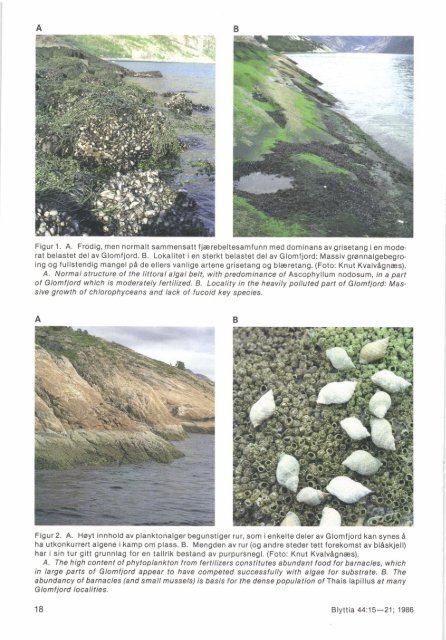Untitled - Universitetet i Oslo
Untitled - Universitetet i Oslo
Untitled - Universitetet i Oslo
You also want an ePaper? Increase the reach of your titles
YUMPU automatically turns print PDFs into web optimized ePapers that Google loves.
Figur 1. A. Frodig, men normalt sammensatt fjerebeltesamf unn med dominans av grisetang i en moderat<br />
belastet del av Glomfjord. B. Lokalitet i en sterkt belastet del av Glomfjord: Massiv gronnalgebegro.<br />
ing og fullstendig mangel pA de ellers vanlige artene grisetang og bl@retang. (Foto: Knut KvalvAgnas).<br />
A. Normal structure of the Iittoral algal belt, with predominance of Ascophyllum nodosum, in a parl<br />
ot Glomfiord which is moderately fertilized. B. Locality in the heavily polluted part of Glomfiord: Massive<br />
growth ol chlorophyceans and lack of fucoid key species.<br />
Figur 2. A. Hoyt innhold av planktonalger begunstiger rur, som i enkelte deler av Glomfjord kan synes A<br />
ha utkonkurrert algene i kamp om plass. B. Mengden av rur (og andre steder tett forekomst av blAskjell)<br />
har i sin tur gitt grunnlag for en tallrik bestand av purpursnegl. (Foto: Knut Kvalv6gnas).<br />
A. The high content ot phytoplankton trcm lertilizerc constitutes abundant food for barnacles, which<br />
in large parts of Glomfiord appear to have competed successlully with algae for substrate. B. The<br />
abundancy of barnacles (and small musse/s/ ls basis f or the dense population of Thais lapillus at many<br />
Glomfiord localities.<br />
18 Blyttia 44:'15-21 ; 1986

















